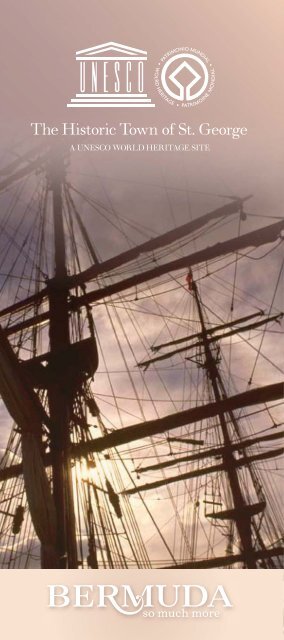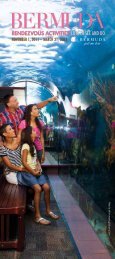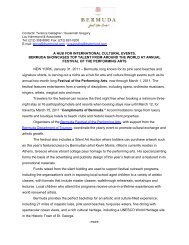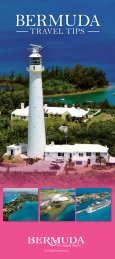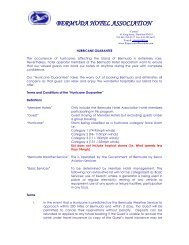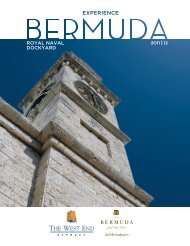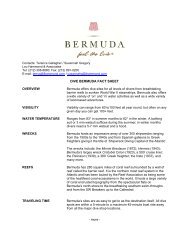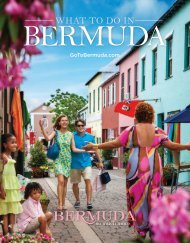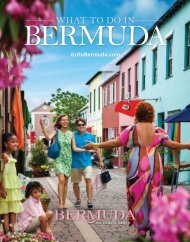The Historic Town of St. George, A UNESCO World ... - Bermuda
The Historic Town of St. George, A UNESCO World ... - Bermuda
The Historic Town of St. George, A UNESCO World ... - Bermuda
Create successful ePaper yourself
Turn your PDF publications into a flip-book with our unique Google optimized e-Paper software.
<strong>The</strong> <strong>Historic</strong> <strong>Town</strong> <strong>of</strong> <strong>St</strong>. <strong>George</strong><br />
A <strong>UNESCO</strong> WORLD HERITAGE SITE
<strong>The</strong> <strong>Historic</strong> <strong>Town</strong> <strong>of</strong> <strong>St</strong>. <strong>George</strong><br />
& RELATED FORTIFICATIONS<br />
A Unique Experience<br />
Joining an elite group <strong>of</strong> recognised world treasures that includes<br />
Monticello in America, the Taj Mahal in India, the Great Wall <strong>of</strong><br />
China and the Great Pyramids <strong>of</strong> Egypt is <strong>Bermuda</strong>’s <strong>UNESCO</strong><br />
<strong>World</strong> Heritage Site, the <strong>Historic</strong> <strong>Town</strong> <strong>of</strong> <strong>St</strong>. <strong>George</strong> and Related<br />
Fortifications. No <strong>Bermuda</strong> vacation is complete without a visit to<br />
historic <strong>St</strong>. <strong>George</strong>’s, located in the east end <strong>of</strong> the island. <strong>St</strong>eeped<br />
in history, the <strong>Town</strong> <strong>of</strong> <strong>St</strong>. <strong>George</strong> is the oldest continuously<br />
inhabited town <strong>of</strong> English origin in the New <strong>World</strong>. <strong>St</strong>. <strong>George</strong>’s<br />
is unique because it is a ‘living’ heritage experience, where<br />
history comes vividly to life amidst the modern amenities and<br />
attractions <strong>of</strong> the <strong>Town</strong>. Not to be outdone, the fortifications in<br />
<strong>St</strong>. <strong>George</strong>’s and its surrounding islands are without parallel. First<br />
constructed in 1612, they include a near complete collection <strong>of</strong><br />
British fortifications and artillery overseas. We therefore invite you<br />
to explore over 400 years <strong>of</strong> the Island’s heritage and enjoy this<br />
jewel in <strong>Bermuda</strong>’s crown.<br />
What is a <strong>World</strong> Heritage Site?<br />
<strong>The</strong> <strong>World</strong> Heritage programme is<br />
coordinated by the United Nations<br />
Educational, Scientific and Cultural<br />
Organisation (<strong>UNESCO</strong>) to encourage<br />
the identification, protection and<br />
preservation <strong>of</strong> outstanding cultural and<br />
natural heritage sites around the world.
Traffic Flow<br />
Bus <strong>St</strong>op<br />
Parks &<br />
Gardens<br />
Church<br />
Cemetery<br />
`<strong>St</strong>ockd<br />
7<br />
Post Office<br />
Vistor Information<br />
Centre<br />
5<br />
`Hillcrest´<br />
Pharmacy<br />
Ferry<br />
ADHT<br />
`Harbour<br />
View´<br />
6<br />
`Hermit’s<br />
Court´ 9<br />
`<strong>St</strong>e<br />
Hal<br />
`Somerled´ 10<br />
`Seve<br />
11<br />
<strong>Bermuda</strong><br />
National Trust<br />
Fortification/Fort<br />
Park Land &<br />
Nature Reserve<br />
Attraction<br />
Ebenezer<br />
Methodist<br />
Church<br />
4<br />
12<br />
13<br />
`Tucker<br />
House´<br />
Bus Route<br />
Other Roads<br />
Railway Trail<br />
Long<br />
House<br />
3<br />
Cemeteries<br />
Hunter<br />
Building<br />
2<br />
1<br />
SITES OF INTEREST<br />
Barber’s Alley 12<br />
Bermudian Heritage Museum 33 $<br />
‘Casino’ (Church) 32<br />
Deliverance 26 $<br />
Ebenezer Methodist Church 4<br />
Ethiopian Orthodox Church*<br />
‘Esten House’ (Art Gallery/Shops) 20<br />
Hannibal Lodge*<br />
‘Hillcrest’ (Aunt Nea’s Inn) 5<br />
King's Square 21<br />
Long House (Art <strong>St</strong>udio) 3<br />
‘Mitchell House’ (<strong>St</strong>. <strong>George</strong>’s<br />
<strong>Historic</strong>al Society Museum) 23 $<br />
Somers' Garden 30<br />
<strong>St</strong>. <strong>George</strong>'s Post Office 14<br />
<strong>St</strong>. Peter’s, <strong>The</strong>ir Majesties Chappell 17<br />
<strong>St</strong>ate House 31<br />
‘<strong>St</strong>ewart Hall’ (<strong>Bermuda</strong> Perfumery) 8<br />
<strong>St</strong>iles House (Bank) 22<br />
‘<strong>The</strong> Globe Hotel’ (<strong>Bermuda</strong><br />
National Trust) 19 $<br />
‘Tucker House’ 13 $<br />
<strong>Town</strong> Hall 25<br />
Unfinished Church 24<br />
<strong>World</strong> Heritage Centre 1
24<br />
ale´<br />
Old Rectory<br />
15<br />
Broad<br />
Alley<br />
16<br />
Cottages<br />
18<br />
`Whitehall´<br />
`Mitchell<br />
House´<br />
23<br />
30<br />
Somers’ Garden<br />
Fort <strong>George</strong><br />
Fort William<br />
wart<br />
l´<br />
8<br />
17<br />
<strong>St</strong>. Peter’s,<br />
<strong>The</strong>ir Majesties<br />
Chappell<br />
`Reeve<br />
Court´<br />
`Bridge<br />
House´ 28<br />
27<br />
<strong>St</strong>ate<br />
House<br />
`Casino´<br />
31<br />
33<br />
32<br />
3<br />
n Gables´<br />
14<br />
<strong>St</strong>.<strong>George</strong>’s<br />
Post Office 2<br />
Martello<br />
Tower<br />
1<br />
19<br />
`<strong>The</strong><br />
Globe<br />
Hotel´<br />
Ferry Island Fort<br />
&<br />
Burnt Point Fort<br />
22<br />
`<strong>St</strong>iles<br />
House´<br />
21<br />
20<br />
`Esten<br />
House´<br />
25 <strong>Town</strong><br />
Hall<br />
Deliverance<br />
26<br />
29<br />
`Buckingham´<br />
HAMILTON<br />
PARISH<br />
PRIVATE RESIDENCES<br />
‘Bridge House’ 27<br />
Hunter Building 2<br />
Broad Alley Cottages 16<br />
Old Rectory 15<br />
‘Buckingham’ 29<br />
‘Reeve Court’ 28<br />
‘Durnford’*<br />
‘Seven Gables’ 11<br />
‘Fanny Fox’s Cottage’*<br />
‘Somerled’ 10<br />
‘Harbour View’ (This Old House:<br />
Somers Playhouse*<br />
<strong>Bermuda</strong> 2004) 6<br />
‘<strong>St</strong>ockdale’ 7<br />
‘Hermit’s Court’ (Pilot Darrell’s House<br />
‘Whitehall’* 18<br />
and Square) 9<br />
Trott’s<br />
Pond<br />
Note:<br />
Mangrove<br />
Lake<br />
$ Admission or Donation<br />
* Indicates properties outside <strong>of</strong> the map perimeters.
<strong>World</strong> Heritage Site<br />
Our <strong>UNESCO</strong><br />
WORLD HERITAGE SITE<br />
In December 2000, <strong>UNESCO</strong> <strong>World</strong> Heritage status was awarded<br />
to the <strong>Historic</strong> <strong>Town</strong> <strong>of</strong> <strong>St</strong>. <strong>George</strong> and Related Fortifications,<br />
<strong>Bermuda</strong>. <strong>The</strong> <strong>Town</strong> <strong>of</strong> <strong>St</strong>. <strong>George</strong> is an outstanding example<br />
<strong>of</strong> the earliest English urban settlement in the New <strong>World</strong>. Its<br />
associated fortifications graphically illustrate the development <strong>of</strong><br />
English military engineering from the 17th to the 20th century, being<br />
adapted to take account <strong>of</strong> the development <strong>of</strong> artillery over<br />
this period.<br />
To find out more visit: www.unesco.org<br />
Experience 400 Years<br />
<strong>of</strong> Living History<br />
<strong>St</strong>. <strong>George</strong>’s is where <strong>Bermuda</strong> began.<br />
Known by mariners as the Isle <strong>of</strong> Devils, it<br />
became inhabited after an English ship,<br />
the Sea Venture, wrecked on the reefs <strong>of</strong><br />
the East End in 1609. Remarkably, the ship’s<br />
company survived. All but two eventually<br />
continued with their original purpose <strong>of</strong><br />
taking supplies to the starving settlement<br />
at Jamestown, Virginia. <strong>The</strong> decision was<br />
<strong>The</strong> <strong>Town</strong> <strong>of</strong><br />
<strong>St</strong>. <strong>George</strong>,<br />
named after<br />
the legendary<br />
dragon slayer<br />
and patron saint<br />
<strong>of</strong> England...<br />
made to claim <strong>Bermuda</strong> for the Crown and, in 1612 the Plough<br />
arrived with <strong>Bermuda</strong>’s first true settlers. <strong>The</strong> <strong>Town</strong> <strong>of</strong> <strong>St</strong>. <strong>George</strong>,<br />
named after the legendary dragon slayer and patron saint <strong>of</strong><br />
England, was <strong>Bermuda</strong>’s capital for more than 200 years. Today,<br />
nearly four centuries later, evidence <strong>of</strong> its remarkable history is<br />
all around you. A series <strong>of</strong> new initiatives is underway to bring<br />
this remarkable history to life, coordinated by <strong>The</strong> <strong>St</strong>. <strong>George</strong>’s<br />
Foundation, an independent, not-for-pr<strong>of</strong>it organisation working<br />
in partnership with the Corporation <strong>of</strong> <strong>St</strong>. <strong>George</strong>, the <strong>Bermuda</strong><br />
Government, public and private sectors and the local community.<br />
3
<strong>St</strong>. <strong>George</strong> ' s<br />
Travelling to the <strong>World</strong> Heritage Site<br />
You can take the Number 1, 3, 10 or 11 buses to <strong>St</strong>. <strong>George</strong>’s<br />
from the City <strong>of</strong> Hamilton. In addition, the Number 6 bus travels<br />
from the <strong>Town</strong> <strong>of</strong> <strong>St</strong>. <strong>George</strong> to <strong>St</strong>. David’s. Tickets need to be<br />
purchased in advance or correct change will be accepted by the<br />
driver. Day or weekly Transportation Passes, for use on both the<br />
ferries and the buses, are also available; these can be purchased<br />
from the Post Office or the Visitor Information Centre and also<br />
from the Central Terminal in the City <strong>of</strong> Hamilton. For bus fares<br />
and schedules call 292-3851 or check the transportation page<br />
on www.gov.bm.<br />
A ferry service operates during the summer months between the<br />
Royal Naval Dockyard and the <strong>Town</strong> <strong>of</strong> <strong>St</strong>. <strong>George</strong>. For enquiries<br />
call 295-4506. Brochures <strong>of</strong> the bus and ferry schedules are also<br />
conveniently available.<br />
A private mini-bus service operates from King’s Square to Tobacco<br />
Bay, Gates’ Bay, Achilles Bay and Fort <strong>St</strong>. Catherine.<br />
<strong>The</strong> easiest way to get to Ferry Reach, <strong>St</strong>. <strong>George</strong>’s is by rental<br />
scooter or taxi. <strong>The</strong> Number 1, 3, 10 or 11 buses will drop you <strong>of</strong>f<br />
at the junction <strong>of</strong> Mullet Bay Road and Ferry Road and from there<br />
it is a 30-minute walk.<br />
Key<br />
African Diaspora Heritage Trail (ADHT):<br />
Offically designated a <strong>UNESCO</strong> Slave Route Project.<br />
<strong>Bermuda</strong> National Trust owned and maintained property.<br />
Map reference number <strong>Town</strong> <strong>of</strong> <strong>St</strong>. <strong>George</strong><br />
4
<strong>World</strong> Heritage Site<br />
<strong>Historic</strong> Sites <strong>of</strong> Interest<br />
Protected by legislation since 1950, the<br />
<strong>Town</strong> <strong>of</strong> <strong>St</strong>. <strong>George</strong> contains the highest<br />
proportion <strong>of</strong> historic buildings<br />
in the entire Island. In addition, the<br />
<strong>Town</strong> has been designated a <strong>Historic</strong><br />
Protected Area to preserve its unique<br />
architecture.<br />
Ro<strong>of</strong>s are made <strong>of</strong><br />
limestone slate,<br />
which is coated with<br />
white lime-treated<br />
paint, making them<br />
watertight.<br />
Traditional Bermudian architecture has evolved to suit the Island’s<br />
environment and our houses are functional and eco-friendly in<br />
design. Houses are made from local limestone, which makes<br />
them strong and durable while walls are plastered and painted<br />
to make the porous limestone waterpro<strong>of</strong>. Traditionally, ro<strong>of</strong>s are<br />
made <strong>of</strong> limestone slate, which is coated with white lime-treated<br />
paint, making them watertight. A white ro<strong>of</strong> reflects sunlight and<br />
keeps the house interior cool. However, the main function <strong>of</strong> the<br />
<strong>Bermuda</strong> ro<strong>of</strong> is to collect rainwater as the Island has no lakes, rivers<br />
or streams. Purified by the lime wash, rainwater falling on the<br />
ro<strong>of</strong> is directed along glides or gutters into storage tanks above<br />
or below the ground. <strong>The</strong> solid chimneys provide strength and<br />
support to the gable ends <strong>of</strong> early buildings and once provided<br />
ventilation and heat for cooking. Wooden shutters give protection<br />
from the elements and also keep the house cool in the summer.<br />
While <strong>Bermuda</strong>’s unique style <strong>of</strong> architecture originated in<br />
<strong>St</strong>. <strong>George</strong>’s, buildings in the <strong>Town</strong> contain many features not<br />
found elsewhere on the Island, such as high walls and gates, lateral<br />
steps and distinct ro<strong>of</strong> eaves.<br />
While many <strong>of</strong> these buildings are private homes and can only<br />
be viewed from the outside, during the annual Christmas Walkabout<br />
many <strong>of</strong> the private residences owned by the <strong>Bermuda</strong><br />
National Trust are opened to the public (see Cultural Activities<br />
pages 16–18).<br />
5
<strong>St</strong>. <strong>George</strong> ' s<br />
<strong>World</strong> Heritage Centre<br />
19 Penno’s Wharf<br />
<strong>The</strong> Queen’s Warehouse, built 1860, was completely renovated<br />
in 2005 to become the <strong>World</strong> Heritage Centre (WHC), home <strong>of</strong><br />
the <strong>St</strong>. <strong>George</strong>'s Foundation. <strong>The</strong> forecourt has been<br />
completely remodelled, while a new state-<strong>of</strong>-the-art lecture<br />
hall and new interactive exhibits were completed in 2009,<br />
when the WHC was <strong>of</strong>ficially opened. <strong>The</strong> original warehouse<br />
pulley system, used to lift trade goods to the upper floor, is still<br />
visible inside the building.<br />
6
<strong>World</strong> Heritage Site<br />
Find out why <strong>St</strong>. <strong>George</strong>’s and related fortifications have been<br />
designated a <strong>UNESCO</strong> <strong>World</strong> Heritage site at this cultural centre.<br />
Take a step back in time and enjoy the orientation, ’<strong>St</strong>. <strong>George</strong>’s<br />
– A Gateway to <strong>Bermuda</strong>’ and the short film, ’A <strong>St</strong>roll through<br />
<strong>St</strong>. <strong>George</strong>’s’ along with the delightful bargains available at the<br />
'Second Hand Rose' shop.<br />
297-5791 | www.stgeorgesfoundation.org.<br />
Water <strong>St</strong>reet<br />
Now a collection <strong>of</strong> shops, restaurants,<br />
artists’ galleries and museums,<br />
Water <strong>St</strong>reet, as its name<br />
suggests, was once the original<br />
coastline <strong>of</strong> the <strong>Town</strong> <strong>of</strong> <strong>St</strong>.<br />
<strong>George</strong>. Between 1693 and 1721<br />
wharves and storehouse were built<br />
by local merchants to the south <strong>of</strong><br />
Water <strong>St</strong>reet.<br />
‘ Tucker House’<br />
5 Water <strong>St</strong>reet<br />
Built in 1752, ’Tucker House’ contains<br />
historic furniture, paintings,<br />
silver services and archaeological<br />
exhibits.<br />
297-0545 | www.bnt.bm<br />
Barber’s Alley<br />
Next to ’Tucker House’ is Barber’s<br />
Alley where Joseph Hayne Rainey,<br />
a former slave who escaped to<br />
<strong>Bermuda</strong>, worked as a barber in<br />
the kitchen <strong>of</strong> ’Tucker House’.<br />
Rainey later returned to America<br />
after the American Civil War and<br />
became a U.S. Congressman.<br />
Midway up Barber’s Alley on the<br />
eastern side is the secluded but beautiful Smith’s Garden, which<br />
is maintained by the Garden Club <strong>of</strong> <strong>Bermuda</strong>.<br />
7
<strong>St</strong>. <strong>George</strong> ' s<br />
<strong>St</strong>. <strong>George</strong>’s Post Office<br />
11 Water <strong>St</strong>reet<br />
<strong>The</strong> site <strong>of</strong> the <strong>Town</strong>’s first gaol and<br />
Provost Marshal’s House, built in<br />
1622 by Governor Butler, the<br />
building was rebuilt in 1760. Many<br />
American privateers during the<br />
Revolutionary War were incarcerated<br />
here by Governor Bruere,<br />
who treated them as pirates instead<br />
<strong>of</strong> prisoners <strong>of</strong> war. In 1800,<br />
the Methodist preacher John <strong>St</strong>ephenson was jailed here for<br />
preaching to Black Bermudians without a licence. Local tradition<br />
has it that he continued to preach through the jail window to his<br />
congregation outside.<br />
Now the Parish Post Office where a free internet kiosk is available<br />
inside.<br />
King’s Square<br />
Her Majesty <strong>The</strong> Queen<br />
inspecting the <strong>Bermuda</strong> Regiment<br />
in King’s Square in 2009<br />
A tidal creek originally ran through<br />
this area, which can be seen in the<br />
1624 engraving by Capt. John<br />
Smith. <strong>The</strong> land was soon reclaimed<br />
and King’s Square has remained<br />
the focal point <strong>of</strong> the <strong>Town</strong><br />
<strong>of</strong> <strong>St</strong>. <strong>George</strong> for hundreds <strong>of</strong><br />
years. All major ceremonies take<br />
place in King’s Square from the annual<br />
Peppercorn Ceremony (see<br />
Cultural Activities) to the regular<br />
ducking <strong>of</strong> the <strong>Town</strong> gossip.<br />
<strong>The</strong> Square contains a replica stocks, pillory and whipping post<br />
which are, perhaps, the <strong>Town</strong>’s most photographed features. Her<br />
Majesty <strong>The</strong> Queen visited King’s Square as part <strong>of</strong> the Island’s<br />
400 th Anniversary Celebrations in 2009.<br />
8
<strong>World</strong> Heritage Site<br />
Ordnance Island & the Deliverance<br />
Now used as a cruise ship berth, a<br />
park and H.M. Customs for visiting<br />
yachtsmen, Ordnance Island was<br />
originally two islands, Ducking <strong>St</strong>ool Island and Gallows Island,<br />
where punishments were meted out and executions were conducted.<br />
In 1795, a canny Scot, Simon Fraser, purchased the islands<br />
from the <strong>Town</strong> for £100. By 1799, he had merged them into<br />
one island and in 1814 sold it to the British War Department for<br />
£14,193. Used to house the Ordnance Department, where it gets<br />
its name, and later the Royal Engineers, Ordnance Island was<br />
later converted into a submarine base during the Second <strong>World</strong><br />
War by the U.S. Navy.<br />
A replica <strong>of</strong> the Deliverance,<br />
which has been recently<br />
restored and contains new<br />
animatronic exhibits, is<br />
located on Ordnance Island<br />
A replica <strong>of</strong> the Deliverance, the<br />
ship built by the Sea Venture castaways<br />
in 1610, which has been recently<br />
restored and contains new<br />
animatronic exhibits, is located on<br />
Ordnance Island.<br />
297-5791 or 297-0045<br />
<strong>Town</strong> Hall<br />
5 King’s Square<br />
<strong>Town</strong> Hall is the meeting place<br />
<strong>of</strong> the Corporation <strong>of</strong> <strong>St</strong>. <strong>George</strong>.<br />
It contains cedar furnishings<br />
and a collection <strong>of</strong> portraits <strong>of</strong><br />
past mayors.<br />
297-1532.<br />
9
<strong>St</strong>. <strong>George</strong> ' s<br />
‘ <strong>The</strong> Globe Hotel ’<br />
32 Duke <strong>of</strong> York <strong>St</strong>reet<br />
Built in 1699 as the second Government<br />
House, Governor Samuel<br />
Day used his father’s political connections,<br />
as the Mayor <strong>of</strong> Bristol,<br />
to keep the building when his<br />
term <strong>of</strong> <strong>of</strong>fice ended. However, his<br />
father’s influence could not keep<br />
Day out <strong>of</strong> debtor’s prison, where<br />
he eventually died while incarcerated<br />
on Castle Island. <strong>The</strong> building was also the headquarters <strong>of</strong><br />
the Confederate shipping agent, Major Norman Walker, during<br />
the American Civil War when this building was <strong>The</strong> Globe Hotel.<br />
This museum, now <strong>The</strong> <strong>Bermuda</strong> National Trust Museum at the<br />
Globe Hotel, highlights <strong>Bermuda</strong>’s involvement in the American<br />
Civil War in a self-guided exhibit, ’Rogues & Runners: <strong>Bermuda</strong><br />
and the American Civil War’. Another video presentation tells the<br />
story <strong>of</strong> <strong>Bermuda</strong>, ’<strong>Bermuda</strong>: Centre <strong>of</strong> the Atlantic’. <strong>The</strong>re is also<br />
the 'Trustworthy' museum and souvenir shop.<br />
297-1423 | www.bnt.bm<br />
<strong>St</strong>. Peter’s,<br />
<strong>The</strong>ir Majesties Chappell<br />
33 Duke <strong>of</strong> York <strong>St</strong>reet<br />
In 2012, in honour <strong>of</strong><br />
<strong>St</strong> Peter’s 400 th anniversary,<br />
Her Majesty <strong>The</strong> Queen,<br />
celebrating her Diamond<br />
Jubilee, granted the<br />
church the Royal title<br />
‘<strong>The</strong>ir Majesties Chappell’<br />
<strong>St</strong> Peter’s Church is the oldest<br />
Anglican Church in continuous use outside the British Isles and,<br />
until the building <strong>of</strong> the <strong>St</strong>ate House, was <strong>Bermuda</strong>’s only public<br />
meeting place. <strong>The</strong> first criminal court was held here in 1616 and<br />
the first meeting <strong>of</strong> Parliament in 1620. <strong>The</strong> original wooden<br />
church dating from 1612, was replaced by a stone structure in<br />
1713, and extended in 1814. On display in the vestry are 17th<br />
century communion silver presented by King William III and two<br />
<strong>of</strong> the oldest pieces <strong>of</strong> furniture in <strong>Bermuda</strong>, a <strong>Bermuda</strong> Cedar<br />
Communion Table and Dole Cupboard. To the west <strong>of</strong> the church<br />
10
<strong>World</strong> Heritage Site<br />
are the graves <strong>of</strong> many slaves and free Blacks, including Pilot<br />
James Darrell (see Hermit’s Court, below). Notable graves elsewhere<br />
in the churchyard include those <strong>of</strong> Midshipman Dale, Governor<br />
<strong>George</strong> James Bruere and Governor Sir Richard Sharples. In<br />
2012, in honour <strong>of</strong> <strong>St</strong> Peter’s 400th anniversary, Her Majesty <strong>The</strong><br />
Queen, celebrating her Diamond Jubilee, granted the church the<br />
Royal title ‘<strong>The</strong>ir Majesties Chappell’, a term first used during the<br />
reign <strong>of</strong> King William and Queen Mary.<br />
<strong>The</strong> new <strong>St</strong>. Peter’s Banner and Flag<br />
<br />
‘<strong>St</strong>ewart Hall ’<br />
5 Queen <strong>St</strong>reet<br />
Built before 1707, ‘<strong>St</strong>ewart Hall’<br />
was the home <strong>of</strong> the prominent local<br />
architect and merchant, Walter<br />
Mitchell. However, it is named after<br />
a later owner, Solicitor-General<br />
and Attorney General, Duncan<br />
<strong>St</strong>ewart (circa 1850s) even though<br />
he never lived there. Now owned<br />
by the <strong>Bermuda</strong> National Trust it is<br />
home to the <strong>Bermuda</strong> Perfumery. To the rear <strong>of</strong> the property is a<br />
wonderful garden, which is open to the public and which features<br />
above ground water tanks.<br />
293-0627<br />
‘Hermit’s Court ’<br />
(Pilot Darrell House and Square) 5 Aunt Peggy’s Lane<br />
Pilot James ’Jemmy’ Darrell was<br />
one <strong>of</strong> the first Black Bermudians<br />
to own property. A former slave,<br />
he was granted his freedom,<br />
recommended by Admiral <strong>George</strong><br />
Murray, in recognition <strong>of</strong> his skill in<br />
piloting the HMS Resolution<br />
through the Narrows Channel in<br />
1795. Admiral Murray later established the King’s Pilots and<br />
Darrell was one <strong>of</strong> the first to be appointed. Darrell’s memorial is<br />
located in <strong>St</strong>. Peter’s Churchyard.<br />
private residence<br />
11
<strong>St</strong>. <strong>George</strong> ' s<br />
Black <strong>St</strong>. Georgians<br />
In the year prior to Emancipation in 1834, almost half <strong>of</strong> Black<br />
Bermudians in <strong>St</strong>. <strong>George</strong>’s Parish were free, the highest proportion<br />
in <strong>Bermuda</strong>. In 1833, Black <strong>St</strong>. Georgians purchased<br />
or were given 23 houses within the <strong>Town</strong> <strong>of</strong> <strong>St</strong>. <strong>George</strong>. <strong>The</strong>se<br />
Black-owned buildings were located throughout the <strong>Town</strong>, indicating<br />
a greater degree <strong>of</strong> integration than found elsewhere on<br />
the Island.<br />
‘ Michell House’<br />
<strong>St</strong>. <strong>George</strong>’s <strong>Historic</strong>al Society<br />
Museum, Printery & Garden<br />
Duke <strong>of</strong> Kent <strong>St</strong>reet<br />
<strong>The</strong> historic ’Mitchell House’<br />
contains fine 18th century cedar<br />
furniture, paintings and <strong>Bermuda</strong><br />
artefacts.<br />
297-0423<br />
‘ Whitehall ’<br />
12 Duke <strong>of</strong> Clarence <strong>St</strong>reet<br />
Probably the largest house in <strong>St</strong>.<br />
<strong>George</strong>’s, ‘Whitehall’ was built in<br />
1815 by John Van Norden while he<br />
was Mayor <strong>of</strong> <strong>St</strong>. <strong>George</strong>’s. Broad<br />
Alley originally ran through the<br />
property but Mayor Van Norden<br />
rerouted the public road around<br />
the property to keep his privacy. A<br />
later Mayor <strong>of</strong> the <strong>Town</strong>, Robert Harley James, added the<br />
impressive Edwardian verandah and entry stairs.<br />
private residence<br />
12
<strong>World</strong> Heritage Site<br />
Old Rectory<br />
1 Broad Alley<br />
This is one <strong>of</strong> the <strong>Town</strong>’s earliest<br />
surviving buildings, built around<br />
1699 by Captain <strong>George</strong> Dew (a<br />
reformed pirate who became a<br />
judge). Its most important features<br />
are the projecting porch with the<br />
short welcoming arms steps and<br />
the eastern chimney set away from<br />
the ro<strong>of</strong> (suggesting that the<br />
house was once thatched). Despite its name, the house was never<br />
<strong>of</strong>ficially a rectory. It is named for Parson Richardson who lived<br />
there between 1763 and 1805.<br />
private residence<br />
Unfinished Church<br />
1 Government Hill Road<br />
This Victorian Gothic church was<br />
begun in 1874 and never finished.<br />
It was intended to be a magnificent<br />
example <strong>of</strong> Victorian Gothic<br />
architecture to replace <strong>St</strong>. Peter’s<br />
Church. <strong>The</strong> new church was beset<br />
by a series <strong>of</strong> problems—financial<br />
difficulties, a rift in the Anglican<br />
congregation and a damaging<br />
storm. Fortunately, we now have an attractive landmark in the<br />
<strong>Town</strong> in addition to a well-preserved <strong>St</strong>. Peter’s—for the death <strong>of</strong><br />
the new church gave continued life to the old.<br />
<strong>The</strong> Gunpowder Plot<br />
Just beyond and on the right <strong>of</strong><br />
the Unfinished Church is Fort<br />
William, which was originally a<br />
government magazine. On 14th<br />
August 1775, several Bermudians,<br />
who sympathised with America,<br />
stole 100 barrels <strong>of</strong> gunpowder<br />
from the magazine under the<br />
nose <strong>of</strong> Governor <strong>George</strong> James<br />
13
<strong>St</strong>. <strong>George</strong> ' s<br />
Bruere, who lived next door. <strong>The</strong> barrels were rolled down the hill<br />
to Tobacco Bay and shipped to General Washington’s Continental<br />
Army. Bruere was incensed and formed a Committee to investigate<br />
the theft. However, unknown to Bruere, several members <strong>of</strong><br />
this Committee, including his own daughter’s father-in-law, Henry<br />
Tucker, were part <strong>of</strong> the conspiracy. Needless to say no one was<br />
ever caught. In 2008, archaeologists discovered Bruere’s unmarked<br />
grave under the floor <strong>of</strong> <strong>St</strong>. Peter’s Church and the former<br />
Governor was entombed in a proper vault with all due ceremony<br />
in the churchyard in 2009.<br />
Somers’ Garden<br />
Reputedly the site where Admiral<br />
Sir <strong>George</strong> Somers’ heart was<br />
buried in 1610, Somers’ Garden is<br />
a public park maintained by<br />
the Corporation <strong>of</strong> <strong>St</strong>. <strong>George</strong>.<br />
Governor John Hope buried his<br />
wife Charlotte here in 1726 and<br />
her tomb can still be seen today.<br />
<strong>The</strong> site originally contained a<br />
cattle pond from 1617 until 1791, when it was filled in by Governor<br />
Hamilton, who replaced it with a well. <strong>The</strong> site was also used as a<br />
vegetable garden by British <strong>of</strong>ficers from the local garrison until<br />
Governor Lefroy <strong>of</strong>ficially designated the area as a public park in<br />
the 1870s.<br />
<strong>The</strong> <strong>St</strong>ate House<br />
4 Princess <strong>St</strong>reet<br />
<strong>The</strong> <strong>St</strong>ate House, built in 1620 and<br />
restored in 1969, is one <strong>of</strong> the<br />
oldest British built stone structures<br />
in the New <strong>World</strong>. Home <strong>of</strong><br />
<strong>Bermuda</strong>’s first parliament (the<br />
oldest surviving parliament in the<br />
world outside the British Isles and<br />
Iceland) and first court, for over<br />
150 years it was the storehouse for<br />
the Island’s gunpowder supplies. Since 1816, it has been rented<br />
by <strong>Bermuda</strong>’s oldest Masonic Lodge, <strong>St</strong>. <strong>George</strong> No. 200 <strong>of</strong> the<br />
Grand Lodge <strong>of</strong> Scotland, for a yearly rent <strong>of</strong> one peppercorn,<br />
paid during a popular public ceremony each April.<br />
14
<strong>World</strong> Heritage Site<br />
Bridge House<br />
1 Bridge <strong>St</strong>reet<br />
Built shortly after 1700, Bridge<br />
House is one <strong>of</strong> the <strong>Town</strong>’s most<br />
picturesque buildings. This was<br />
the home <strong>of</strong> Virginia Governor,<br />
Benjamin Bennett and later <strong>of</strong><br />
Bridger Goodrich, a Virginian<br />
loyalist, whose privateers once<br />
blockaded Chesapeake Bay, much<br />
to the annoyance <strong>of</strong> U.S. President Thomas Jefferson.<br />
private residence<br />
Bermudian Heritage Museum<br />
Junction <strong>of</strong> Duke <strong>of</strong> York and Water <strong>St</strong>reets<br />
<strong>The</strong> first fully exhibited Black<br />
History Museum <strong>of</strong> <strong>Bermuda</strong>,<br />
located in the historic Samaritans’<br />
Lodge.<br />
297-4126<br />
<strong>St</strong>. David’s Island <strong>Historic</strong>al<br />
Society at Carter House<br />
34 Southside Road, <strong>St</strong>. David’s Island<br />
Built in the 17th century by the descendants<br />
<strong>of</strong> Christopher Carter,<br />
who was wrecked on <strong>Bermuda</strong> in<br />
the Sea Venture in 1609, and remains<br />
today largely in its original<br />
form. It is now the museum <strong>of</strong> the<br />
<strong>St</strong>. David’s Island <strong>Historic</strong>al Society<br />
where the culture and history <strong>of</strong><br />
the unique people <strong>of</strong> <strong>St</strong> David’s is<br />
exhibited. Nestled next to Carter House amongst endemic and<br />
native plants and trees as well as <strong>Bermuda</strong> mystery roses, is a replica<br />
settlers' dwelling, c. 1612, built using the same English techniques,<br />
17th century tools and local materials, including a Palmetto<br />
thatched ro<strong>of</strong>—a 400th anniversary project.<br />
293-5960<br />
15
<strong>St</strong>. <strong>George</strong> ' s<br />
Cultural Activities<br />
Free Guided Tours<br />
Free guided tours <strong>of</strong> the <strong>Town</strong> begin<br />
in King’s Square at 10:30am several<br />
times a week, including Monday<br />
through Thursday during the summer<br />
months and Wednesdays and<br />
Saturdays between November and<br />
March.<br />
<strong>Historic</strong>al Re-enactment<br />
<strong>The</strong> <strong>Town</strong> Crier attends King’s Square<br />
at 12 noon to mete out punishment<br />
on the <strong>Town</strong> Drunk and the <strong>Town</strong><br />
Gossip. Visitors are invited to assist in<br />
ducking the wench into <strong>St</strong>. <strong>George</strong>’s<br />
Harbour, Monday through Thursday<br />
and Saturdays during the summer months and Wednesdays and<br />
Saturdays during the winter.<br />
<strong>St</strong>. <strong>George</strong>’s Olde <strong>Town</strong>e Market<br />
Experience an old European-style<br />
street market <strong>of</strong> yesteryear. Explore<br />
the hidden treasures along Water<br />
<strong>St</strong>reet while enjoying local foods, arts<br />
and crafts, fresh local produce and a<br />
pedlars' market. Held most Saturdays,<br />
11am–4pm, from March to July and from end-October to<br />
mid-December.<br />
16
<strong>World</strong> Heritage Site<br />
Peppercorn Ceremony<br />
<strong>The</strong> Peppercorn Ceremony is an<br />
annual event held in April on the<br />
Wednesday closest to <strong>St</strong>. <strong>George</strong>’s<br />
Day, when the members <strong>of</strong> Lodge<br />
<strong>St</strong>. <strong>George</strong> pay their annual rent<br />
(a single peppercorn) for the use <strong>of</strong><br />
the <strong>St</strong>ate House. Preceded by a 17-gun salute, the Governor,<br />
dressed in full regalia, arrives in a horse drawn carriage and<br />
inspects a military guard <strong>of</strong> honour before accepting his rent.<br />
<strong>The</strong> <strong>Bermuda</strong> Regiment performs close order drills in King’s<br />
Square to the accompaniment <strong>of</strong> music from the band <strong>of</strong> the<br />
<strong>Bermuda</strong> Regiment.<br />
Midshipman Dale<br />
Remembrance Ceremony<br />
Midshipman Richard Sutherland Dale<br />
served in the U.S. Navy and was<br />
wounded <strong>of</strong>f the coast <strong>of</strong> <strong>Bermuda</strong><br />
fighting the British in 1812. Captured<br />
by the British, he was compassionately cared for<br />
by the people <strong>of</strong> <strong>St</strong>. <strong>George</strong>’s. Unfortunately he died <strong>of</strong> his<br />
wounds and was the last victim <strong>of</strong> the War <strong>of</strong> 1812. Dale was<br />
buried with honours at <strong>St</strong>. Peter’s Church and for many years a<br />
ceremony was held at the gravesite on America’s Memorial Day.<br />
Today, the Friends <strong>of</strong> <strong>St</strong>. Peter’s sponsor a yearly memorial service<br />
in February in honour <strong>of</strong> Midshipman Dale.<br />
Christmas Walkabout<br />
<strong>The</strong> <strong>Bermuda</strong> National Trust’s Christmas<br />
Walkabout is a highlight <strong>of</strong> the<br />
local holiday calendar. On the first<br />
Friday <strong>of</strong> December, come to the<br />
<strong>Town</strong> <strong>of</strong> <strong>St</strong>. <strong>George</strong> where you can<br />
Cultural Activities continued...<br />
17
<strong>St</strong>. <strong>George</strong> ' s<br />
visit a number <strong>of</strong> <strong>Bermuda</strong> National Trust buildings which are not<br />
normally open to the public. <strong>The</strong> event is free and musicians and<br />
carol singers entertain visitors in King’s Square.<br />
Annual Commemorative Service for<br />
King’s Pilot James ‘Jemmy’ Darrell<br />
In honour <strong>of</strong> his skill and dedication<br />
to his work, Pilot ‘Jemmy’ Darrell is<br />
remembered in an annual ceremony<br />
each April at his grave in <strong>St</strong>. Peter’s<br />
Graveyard. Turn to page 11 for more<br />
information on this outstanding<br />
person.<br />
Beaches<br />
<strong>Bermuda</strong>’s beaches are some <strong>of</strong> the most beautiful<br />
in the world. Those within the <strong>World</strong> Heritage<br />
Site are easily accessible.<br />
Tobacco Bay<br />
A 10-15 minute walk up Duke <strong>of</strong><br />
Kent <strong>St</strong>reet and over the hill to the<br />
north shore brings you to one <strong>of</strong> the<br />
more popular beaches in <strong>St</strong>.<br />
<strong>George</strong>’s. <strong>The</strong> unusual limestone<br />
formations <strong>of</strong>f the shoreline are a<br />
haven for parrot fish, sergeant majors,<br />
blue angels, four-eyed butterfly fish and wrasse and an excellent<br />
snorkelling spot. Because <strong>of</strong> its shallow waters, this sheltered<br />
18
<strong>World</strong> Heritage Site<br />
bay is perfect for families and inexperienced swimmers. A beach<br />
house is open in the summer months and a minibus is available<br />
from King’s Square.<br />
Gates’ Bay and Achilles Bay<br />
Located on the eastern flank <strong>of</strong> Fort<br />
<strong>St</strong>. Catherine, Gates’ Bay, also commonly<br />
referred to as <strong>St</strong>. Catherine’s<br />
Beach, is the largest beach in <strong>St</strong>.<br />
<strong>George</strong>’s. It is also the historic landing<br />
spot on which the shipwrecked<br />
survivors <strong>of</strong> the Sea Venture<br />
stepped foot. Achilles Bay is a small bay found on the western<br />
flank <strong>of</strong> Fort <strong>St</strong>. Catherine.<br />
Whalebone Bay<br />
Located in Ferry Point Park, this<br />
sheltered, shallow bay is part <strong>of</strong> one<br />
the Island’s largest national parks,<br />
which contains a number <strong>of</strong> historic<br />
fortifications and great hiking trails.<br />
Clearwater Beach and Turtle Bay<br />
Located on <strong>St</strong>. David’s Island, the<br />
spaciousness <strong>of</strong> these two sandy<br />
beaches are ideal for families. <strong>The</strong><br />
36-acre public park features nature<br />
trails, playground equipment and<br />
views <strong>of</strong> some outer islands reserved<br />
for wildlife. A beach house is<br />
open during the summer months.<br />
Cooper’s Island Nature Reserve<br />
Just beyond Clearwater Beach and<br />
Turtle Bay you enter the Cooper’s<br />
Island Nature Reserve and even<br />
more stunning beaches such as<br />
Long Bay… <strong>Bermuda</strong> treasures<br />
for sure!<br />
19
<strong>St</strong>. <strong>George</strong> ' s<br />
<strong>Historic</strong> Cemeteries<br />
<strong>St</strong>. Peter’s Churchyard<br />
<strong>St</strong>. Peter’s Churchyard closed in the<br />
mid-19th century and other cemeteries<br />
were established around the<br />
<strong>Town</strong> for the local population and<br />
the British Military, who maintained<br />
a garrison in the <strong>Town</strong>.<br />
Notable graves at <strong>St</strong>. Peter’s are<br />
Midshipman R.S. Dale, who died as a prisoner <strong>of</strong> war in <strong>St</strong>.<br />
<strong>George</strong>’s in 1815, slave pilot Jemmy Darrell and Ann Bingham,<br />
the ’Jackie Kennedy’ <strong>of</strong> the American Revolution whose bust is<br />
featured on early U.S. coins. Besides Midshipman Dale, it is believed<br />
that 14 other American prisoners <strong>of</strong> war are interred in the<br />
Churchyard. <strong>The</strong>re are only two modern graves in this cemetery:<br />
Governor Sir Richard Sharples and his ADC, Captain Hugh Sayers,<br />
who were murdered in 1973.<br />
Secretary Road Cemetery<br />
Located on Cemetery Hill and adjacent<br />
to the current local cemetery,<br />
this cemetery was used by the British<br />
Military from the mid-19th century<br />
until the early 20th century.<br />
Here lies the grave <strong>of</strong> <strong>George</strong> Samson,<br />
who won the Victoria Cross at<br />
Gallipoli in the First <strong>World</strong> War. His funeral in February 1923 was<br />
the largest military internment ever held in <strong>Bermuda</strong>. Many <strong>of</strong> the<br />
memorials are <strong>of</strong> intricate design, while some contain inscriptions<br />
20
<strong>World</strong> Heritage Site<br />
<strong>of</strong> how the servicemen died, such as those who died during the<br />
construction <strong>of</strong> the great forts around the East End, Fort Cunningham<br />
being one.<br />
Grenadier Lane Cemetery<br />
Located near the coast at the junction<br />
<strong>of</strong> Grenadier Lane and Barry<br />
Road, this cemetery was established<br />
in the early 1800s. It was used<br />
by the British Military during the<br />
yellow fever epidemics <strong>of</strong> the 19th<br />
century. <strong>The</strong> most poignant grave<br />
here is that <strong>of</strong> David Milroy, MD, an army surgeon <strong>of</strong> the 30th<br />
Regiment. He served in the Crimean War, participating in the battles<br />
<strong>of</strong> Alma, Inkerman and Sebastopol. While stationed in<br />
<strong>Bermuda</strong> he tended the troops stricken with yellow fever but succumbed<br />
to the dreaded disease on the 3rd, September, 1864,<br />
aged 32.<br />
Ferry Reach Cemetery<br />
Located in Ferry Point Park, this<br />
cemetery was opened by British<br />
Military during the yellow fever outbreak<br />
<strong>of</strong> 1853. Here lie the remains<br />
<strong>of</strong> members <strong>of</strong> the 56th Regiment<br />
who succumbed to yellow fever in<br />
1864. A total <strong>of</strong> 37 soldiers are commemorated<br />
including one sole member <strong>of</strong> the Royal Engineers.<br />
Ferry Point Cemetery<br />
Located in Ferry Point Park, this<br />
cemetery was used by British Military<br />
during the 1860s for victims <strong>of</strong><br />
yellow fever. <strong>The</strong>re are no longer<br />
any visible graves, but back in 1957<br />
four grave markers were still visible.<br />
21
<strong>St</strong>. <strong>George</strong> ' s<br />
Forts <strong>of</strong> <strong>St</strong>. <strong>George</strong> ’ s Parish<br />
<strong>The</strong> fortifications associated with the <strong>Town</strong> <strong>of</strong> <strong>St</strong>.<br />
<strong>George</strong> are unequalled. Nowhere else in the world<br />
will you find in such a small geographical area the<br />
date range and concentration <strong>of</strong> forts spanning<br />
almost the entire history <strong>of</strong> English coastal defence<br />
systems, from the 17th century until the end<br />
<strong>of</strong> coastal defence in 1956. Forts are the oldest stone<br />
buildings in <strong>Bermuda</strong> and represent every stage<br />
<strong>of</strong> the Island’s development from a small, isolated<br />
outpost <strong>of</strong> the British Empire in the 1600s to the<br />
‘Gibraltar <strong>of</strong> the West’ in the 1800s, and beyond.<br />
We begin at the Ferry Reach and Ferry Point area<br />
on the western side <strong>of</strong> <strong>St</strong>. <strong>George</strong>’s Island where<br />
several forts set in what is now public parkland<br />
are easily accessible from the Railway Trail <strong>of</strong>f<br />
Mullet Road. Don’t miss the beautiful views from<br />
Ferry Point.<br />
Key<br />
1 Fortifications are indicated on the Map found on inside<br />
back cover.<br />
22
<strong>World</strong> Heritage Site<br />
Burnt Point Fort<br />
1<br />
One <strong>of</strong> the oldest forts on Ferry Island in <strong>St</strong>. <strong>George</strong>’s, this fort<br />
was built in the mid-1600s to defend the western approach to <strong>St</strong>.<br />
<strong>George</strong>’s Harbour from enemy ships and prevent illegal trading by<br />
Bermudian vessels.<br />
Ferry Island Fort<br />
1<br />
Until 1871, a ferry between Coney<br />
Island and Ferry Island was the only<br />
means <strong>of</strong> transport between <strong>St</strong>.<br />
<strong>George</strong>’s and the mainland. During<br />
the American Revolutionary War, it<br />
was suggested that if <strong>Bermuda</strong> was<br />
attacked the population <strong>of</strong> the main<br />
island should retreat via the ferry to <strong>St</strong>. <strong>George</strong>’s, where a stand<br />
would be made. A battery was built at the top <strong>of</strong> Ferry Island in<br />
the 1790s, which was replaced in the 1870s by the fort you see<br />
today. <strong>The</strong> ruin is open to the public.<br />
Martello Tower<br />
2<br />
<strong>Bermuda</strong>’s only Martello Tower was<br />
built during the 1820s <strong>of</strong> hard<br />
<strong>Bermuda</strong> stone. <strong>The</strong> only access is<br />
by a drawbridge, which crosses the<br />
ditch to the barracks on the second<br />
level. To the north <strong>of</strong> the tower is a<br />
magazine; its walls are reinforced by<br />
flying buttresses and the ro<strong>of</strong> is structurally weaker so that in the<br />
event <strong>of</strong> an explosion, the ro<strong>of</strong> would be blown <strong>of</strong>f leaving the<br />
walls intact. <strong>The</strong> Martello Tower has been recently renovated and<br />
new interpretive signage has been installed.<br />
Martello Tower is open to the public free <strong>of</strong> charge by<br />
appointment only. Department <strong>of</strong> Parks, 236-5902.<br />
Fort <strong>George</strong><br />
3<br />
In 1612, Governor Richard Moore chose this site, the the highest<br />
hill in <strong>St</strong>. <strong>George</strong>'s and known as Riches Mount, for a lookout<br />
tower. Fort <strong>George</strong> was later constructed in 1788, the structure <strong>of</strong><br />
which remains today and is actively occupied by <strong>Bermuda</strong> Radio.<br />
23
<strong>St</strong>. <strong>George</strong> ' s<br />
Fort <strong>St</strong>. Catherine & Museum 5<br />
From the <strong>Town</strong>, follow Duke <strong>of</strong> Kent<br />
<strong>St</strong>reet past the Unfinished Church<br />
and the (former) <strong>St</strong>. <strong>George</strong>’s Golf<br />
Course (a 20-25 minute walk), or<br />
take a minibus from King’s Square.<br />
This is one <strong>of</strong> the East End’s most<br />
popular visitor attractions. In 2009,<br />
the fort underwent a major renovation with new interactive exhibits<br />
installed. <strong>The</strong>se include a newly refurbished Carronade Room,<br />
exhibits on the daily life <strong>of</strong> the soldiers who defended the fort and<br />
magazines with replicas <strong>of</strong> swords, pistols and muskets. <strong>The</strong> gun<br />
floor contains a unique collection <strong>of</strong> Victorian artillery and <strong>of</strong>fers<br />
some <strong>of</strong> the best views <strong>of</strong> the North Shore. Governor Richard<br />
Moore built the original, small fort in 1614 to protect Gates Bay,<br />
the landing place <strong>of</strong> the Sea Venture castaways in 1609. Additions<br />
were made in 1793 and during the 19th century. <strong>The</strong> fort was used<br />
as a training area for local forces in the early 1900s and, during<br />
<strong>World</strong> War II, an American magnetic loop was installed there.<br />
297-1920<br />
Alexandra Battery<br />
6<br />
From Fort <strong>St</strong>. Catherine, head down<br />
the hill and turn left onto Barry<br />
Road, continuing for about one<br />
mile. Alexandra Battery is on the left<br />
(a 20 minute walk). It is Frobisher’s<br />
Buildings Bay where Sir Thomas<br />
Gates supervised the building <strong>of</strong><br />
the Deliverance in 1610. <strong>The</strong> fort was completed in the 1860s and<br />
armed with five 9-inch muzzle-loading guns. <strong>The</strong> 1890s magazine<br />
with the Battery name over its entrance is at the centre <strong>of</strong> the fort.<br />
Climb the steps and enjoy the view from the command post!<br />
Gates Fort<br />
7<br />
From Alexandra Battery, follow Barry<br />
Road a short distance to <strong>Town</strong><br />
Cut. <strong>The</strong> fort is located just before<br />
the road turns hard right and begins<br />
to climb. <strong>St</strong>anding at the edge <strong>of</strong><br />
<strong>Town</strong> Cut, the shipping passage to<br />
<strong>St</strong>. <strong>George</strong>’s Harbour, Davers or<br />
Danvers Fort as it was initially known, was first shown on a map<br />
24
<strong>World</strong> Heritage Site<br />
published in 1626. Rebuilt in the 1790s, the Keep served as barracks<br />
in the 1800s, and was home to a local family from 1870 until<br />
1922, when the property was returned to the <strong>Bermuda</strong> Government.<br />
Forts <strong>of</strong> <strong>St</strong>. David ’ s Island<br />
To see more, travel to <strong>St</strong>. David’s Island staying on<br />
<strong>St</strong>. David’s Road to the end (five-minute ride). Head<br />
straight on to Great Bay Road and after 250 yards<br />
take a right turn onto Battery Road. <strong>St</strong>. David’s<br />
Battery is at the end, in the picturesque Great Head<br />
Park, and Fort Popple is a short walk on.<br />
Fort Popple<br />
9<br />
When Alured Popple became Governor in 1738, he found crumbling<br />
masonry, broken gun carriages and rusting guns at most<br />
<strong>of</strong> <strong>Bermuda</strong>’s forts. Governor Popple energetically refortified the<br />
Island by repairing the existing defences and building several<br />
new forts, including the small fort at Little Head, <strong>St</strong>. David’s. It was<br />
named Fort Popple in his honour. Fort Popple’s position, close to<br />
the sea, made it unsuitable for further development but, in the<br />
early 1900s, a searchlight was placed on the flat behind the fort.<br />
Walk the nature trails in the splendid natural setting <strong>of</strong> Little Head<br />
Park, <strong>St</strong>. David’s and enjoy the breathtaking ocean views from Fort<br />
Popple, situated at the water’s edge <strong>of</strong> the rocky <strong>St</strong>. David’s coast.<br />
<strong>St</strong>. David’s Battery 10<br />
<strong>St</strong>. David’s Battery (1910) was the<br />
last major fortification to be built in<br />
the vicinity <strong>of</strong> <strong>St</strong>. <strong>George</strong>’s. <strong>The</strong> two<br />
major British breech-loading guns<br />
<strong>of</strong> the early 1900s situated side-byside<br />
in the batteries make<br />
<strong>St</strong>. David’s Battery one <strong>of</strong> the world’s<br />
most important British historic military sites. <strong>The</strong> 9.2-inch breechloading<br />
guns at the southern end <strong>of</strong> the Battery had a range <strong>of</strong><br />
approximately seven miles and could have stopped an enemy<br />
vessel well short <strong>of</strong> the Island. But they were never fired in anger<br />
and, because <strong>of</strong> complaints from civilians living nearby, were seldom<br />
fired even in practice! Nearby Fort Popple affords breathtaking<br />
ocean views.<br />
25
<strong>St</strong>. <strong>George</strong> ' s<br />
Forts<br />
NOT OPEN TO THE PUBLIC:<br />
You’ll see many other forts in the vicinity <strong>of</strong> the<br />
<strong>Town</strong> and on islands in <strong>St</strong>. <strong>George</strong>’s Harbour and<br />
Castle Harbour, which are not accessible to the<br />
public. Most significant are:<br />
King’s Castle<br />
11<br />
King’s Castle (1612) is located on<br />
Castle Island and is <strong>Bermuda</strong>’s oldest<br />
fort, with a Captain’s House added<br />
in 1621. It is believed to be the<br />
oldest standing English house in the<br />
New <strong>World</strong>.<br />
Fort Cunningham<br />
8<br />
Fort Cunningham (1870s) is located<br />
on Paget Island and has a unique<br />
iron frontage. This was so expensive<br />
to build that a question was raised<br />
about it in the British Parliament, “Is<br />
it made <strong>of</strong> gold?”<br />
Fort William<br />
4<br />
Constructed in the early 1600s by Richard Moore, the first<br />
Governor <strong>of</strong> <strong>Bermuda</strong>, Fort William was built to protect the <strong>Town</strong><br />
<strong>of</strong> <strong>St</strong>. <strong>George</strong>. Fort William had an inner keep or a fort house with<br />
three floors and surrounded by a dry moat.<br />
26
<strong>World</strong> Heritage Site<br />
Monuments<br />
Somers’ Garden Obelisk<br />
Found in Somers' Garden, <strong>St</strong>. <strong>George</strong>'s, the quote engraved on<br />
this obelisk reads,<br />
“1609-1909<br />
In commemoration <strong>of</strong> the settlement <strong>of</strong> these<br />
islands on the 28th <strong>of</strong> July 1609 and in Honour <strong>of</strong><br />
Sir <strong>George</strong> Somers Kt. at whose instance largely<br />
the settlement was effected this memorial has<br />
been erected <strong>of</strong> a grant made by the legislature <strong>of</strong><br />
this colony.”<br />
<strong>The</strong> Heart <strong>of</strong> Sir <strong>George</strong> is Buried Here<br />
<strong>The</strong> 400th Anniversary<br />
Monument<br />
Courtesy Liz Campbell<br />
This monument looks out over Sea<br />
Venture Shoals, where the few<br />
remains <strong>of</strong> the Sea Venture ship still<br />
lie. It records the names <strong>of</strong> 50 known<br />
Sea Venture survivors, who came<br />
ashore at Gates’ Bay on 28th July<br />
1609. <strong>The</strong>re were about 150<br />
altogether. Before the company left for Jamestown on 10th May<br />
1610, they raised a cross and attached etched copper plates<br />
describing their experience in English and Latin. <strong>The</strong> cross,<br />
originally constructed from Sea Venture salvage, symbolizes the<br />
English claim in the name <strong>of</strong> James I.<br />
<strong>The</strong> Memorial for those<br />
Lost at Sea<br />
’Figurehead’ is the memorial which commemorates<br />
Bermudians lost at sea from the earliest date<br />
<strong>of</strong> colonisation to present day. Located in Great<br />
Head Park.<br />
27
<strong>St</strong>. <strong>George</strong> ' s<br />
Notes<br />
28
<strong>World</strong> Heritage Site<br />
HISTORICAL<br />
Snippets<br />
Crown Jewels<br />
Antique bottles, prisoner-<strong>of</strong>-war<br />
artefacts and the British Crown<br />
Jewels in replica are exhibited in<br />
Fort <strong>St</strong>. Catherine’s keep. At the top<br />
<strong>of</strong> the tower there is an audio-visual<br />
presentation on <strong>Bermuda</strong>’s<br />
many forts.<br />
Cedar Dole Cupboard<br />
Located in <strong>St</strong>. Peter’s, <strong>The</strong>ir Majesties<br />
Chappell, this was originally used to<br />
hold donations <strong>of</strong> alms, usually bread,<br />
to provide for the poor <strong>of</strong> the parish.<br />
<strong>The</strong> <strong>St</strong>atue <strong>of</strong> Sir <strong>George</strong> Somers<br />
On Ordnance Island is a statue <strong>of</strong><br />
Sir <strong>George</strong> Somers, the Admiral<br />
<strong>of</strong> the Sea Venture fleet, sculpted<br />
by Bermudian sculptor, Desmond<br />
Fountain. Nearby, you can visit the<br />
gardens named after Somers, where<br />
his heart is buried.<br />
<strong>St</strong>. David’s Lighthouse<br />
Built in 1879, <strong>St</strong>. David’s Lighthouse<br />
<strong>of</strong>fers a panoramic view which can be<br />
appreciated from the top <strong>of</strong> the hill<br />
even if the lighthouse is closed.<br />
29
<strong>Historic</strong>al Points <strong>of</strong> Interest outside the<br />
<strong>Town</strong> <strong>of</strong> <strong>St</strong>. <strong>George</strong><br />
ST. GEORGE ’ S ISLAND AND ST. DAVID ’ S ISLAND<br />
Fort William<br />
Fort <strong>George</strong><br />
3<br />
Martello<br />
Tower<br />
2<br />
1<br />
Ferry Island Fort<br />
&<br />
Burnt Point Fort<br />
HAMILTON<br />
PARISH<br />
Trott’s<br />
Pond<br />
Mangrove<br />
Lake
5<br />
Fort <strong>St</strong>. Catherine<br />
& Museum<br />
4<br />
Alexandra<br />
Battery<br />
6<br />
Gates Fort<br />
7<br />
Fort<br />
Cunningham<br />
8<br />
Fort Popple<br />
9<br />
Traffic Flow<br />
10<br />
Bus <strong>St</strong>op<br />
<strong>St</strong>. David’s<br />
Parks Battery &<br />
Gardens<br />
Carter House<br />
Church<br />
Cemetery<br />
Post Office<br />
Vistor Information<br />
Centre<br />
Pharmacy<br />
Ferry<br />
ADHT<br />
King’s<br />
Castle<br />
11<br />
<strong>Bermuda</strong><br />
National Trust<br />
Fortification/Fort<br />
Park Land &<br />
Nature Reserve<br />
Attraction<br />
Bus Route<br />
Other Roads<br />
Railway Trail<br />
Cemeteries<br />
Note:<br />
Not all forts are accessible.<br />
Information provided to support the <strong>World</strong> Heritage Centre.
<strong>Bermuda</strong> Department <strong>of</strong> Tourism<br />
Global House<br />
43 Church <strong>St</strong>reet<br />
City <strong>of</strong> Hamilton<br />
Tel: 441 292 0023<br />
GoTo<strong>Bermuda</strong>.com for more information and Events Calendar<br />
1.800.bermuda (Monday – Friday, 9:00 a.m. – 5:00 p.m. EST)<br />
<strong>The</strong> <strong>St</strong>. <strong>George</strong>’s Foundation<br />
Tel: 441 297 8043<br />
Fax: 441 297 2479<br />
Email: directortsgf@logic.bm<br />
Website: www.stgeorgesfoundation.org<br />
<strong>The</strong> <strong>Bermuda</strong> National Trust<br />
Tel: 441 236 6483<br />
Fax: 441 236 0617<br />
Email: palmetto@bnt.bm<br />
Website: www.bnt.bm<br />
<strong>The</strong> Department <strong>of</strong> Parks<br />
Tel: 441 236 5902<br />
Website: www.gov.bm<br />
<strong>The</strong> Corporation <strong>of</strong> <strong>St</strong>. <strong>George</strong><br />
Tel: 441 297 1532<br />
Special thanks to the <strong>World</strong> Heritage Management<br />
Commitee and the Department <strong>of</strong> Planning.<br />
Produced by the <strong>Bermuda</strong> Department <strong>of</strong> Tourism, <strong>The</strong> <strong>St</strong>. <strong>George</strong>’s Foundation, the <strong>Bermuda</strong><br />
National Trust, the Department <strong>of</strong> Parks and the Corporation <strong>of</strong> <strong>St</strong>. <strong>George</strong>. Every effort has been<br />
made to ensure that the information featured in this brochure is accurate and correct at the time <strong>of</strong><br />
printing, September 2012. All fees and conditions are subject to change without notice.<br />
Reproduction only by written permission from the <strong>Bermuda</strong> Department <strong>of</strong> Tourism, Creative<br />
Services Office, 43 Church <strong>St</strong>reet, Hamilton HM 12, <strong>Bermuda</strong>. Reproduction by any method for<br />
financial gain is strictly prohibited.<br />
BDOT/J05221/IP 10M/9.12/1070<br />
Printed in <strong>Bermuda</strong> by Island Press Ltd.


